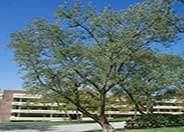
Common name:Parasol Aeonium
Botanical name:Aeonium arboreum
Parasol Aeonium is an upright succulent with rosette leaf clusters. It forms a mound and can be easily propagated by cuttings.

Common name:Shrub Rose
Botanical name:Rosa Shrub varieties
The dark green, heavily veined leaves of this bushy shrub are strong support for the pure white or pink, nearly double flowers it produces. This is a very tolerant, heavily scented plant with an impressive fall color. Also, large hips appear intermittently with this plant.

Common name:Camphor Tree
Botanical name:Cinnamomum camphora
This beautiful evergreen tree has glossy foliage that is light green in color. The new foliage comes in with a tinted red color. Eventually, this tree becomes quite large in size (50'-60' tall and 60' wide).

Common name:Olive
Botanical name:Olea europaea
This broad tree will grow to 40' tall and has small, gray green leaves with fleshy black fruit that appears in fall. Purchase fruitless varieties to avoid the mess.

Common name:Lily of the Nile
Botanical name:Agapanthus hybrids
This evergreen ground cover/shrub will grow about 3' tall and has large green leaves with blue flowers (there is a white variety and dwarf varieties) that bloom in spring and summer. It will grow in all soils but prefers loam soil.

Common name:Compact Karo
Botanical name:Pittosporum crassifolium 'Compactum'
Pittosporum crassifolium 'Nana' is an evergreen shrub or tree. It can reach 25' tall and 20' wide in 8-10 years. Branches are densely clothed in gray green, with 1"-2" long leaves that have rounded ends. It produces maroon flowers in late spring.

Common name:Marina Strawberry Madrone
Botanical name:Arbutus 'Marina'
Marina Strawberry Tree (Arbutus marina) is a small-to-medium evergreen tree that is one of the most popular specimen trees for Southern California gardens. It matures at 40’ tall and 30’ wide and is easily kept in the 15’ range with regular pruning. It has a deep red bark and deep green foliage that resembles a Manzanita. This tree is appropriate in almost any garden setting with almost any soil or moisture level. When it is young, it grows quickly, so it benefits greatly from some selective pruning. The natural growth habit is more shrub-like, especially in the multi-trunk form, so removing some of the lower new branches and exposing the trunk will improve the look and shape. Once the tree canopy is out of reach, a licensed arborist should maintain the tree to keep its natural shape. This tree should be planted at least three feet away from any hardscape areas, eight feet from structures such as houses and buildings, and not near any powerlines. Shrubs and perennials should be planted about two feet away from this tree. It should be irrigated for about 45 minutes once a week when using most in-line drip irrigation systems. This tree is a hybrid of the Arbutus unedo. They share several traits, but the Arbutus ‘Marina’ grows faster and can reach a larger size at maturity. It also has a more reddish tone to its bark color.
Designer: Barbara Lentz
Photographer: GardenSoft
Physical weed control, including mulching, or hand removal protects the watershed from harmful chemicals.
Be sure to fix all leaks promptly no matter how small they may seem.
Attract, or buy beneficial insects such as ladybugs and lacewings to control pest outbreaks in your garden.